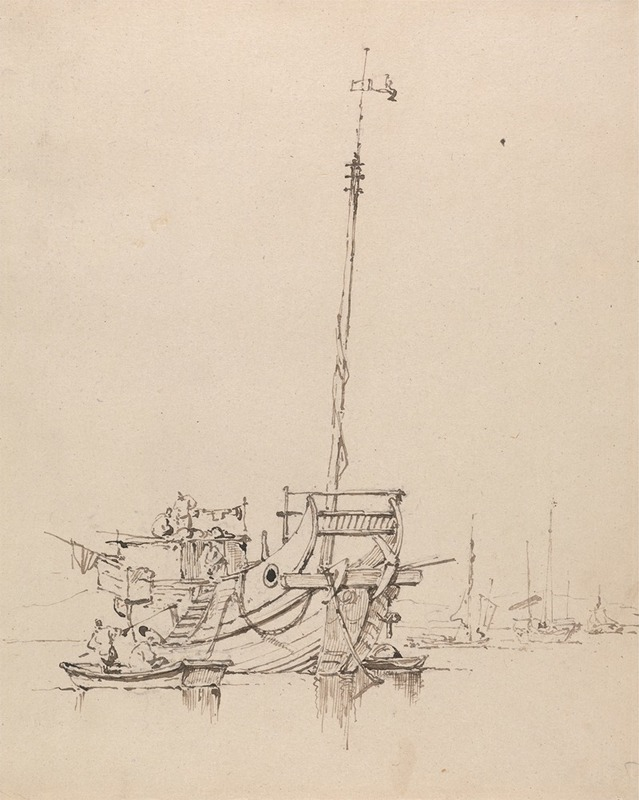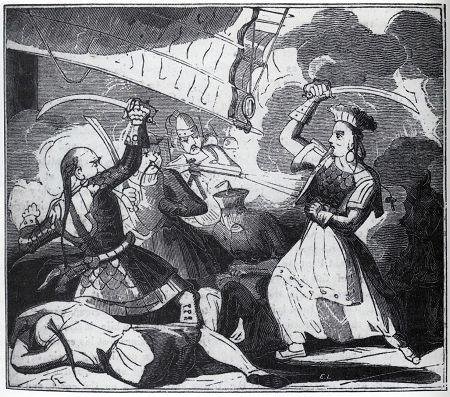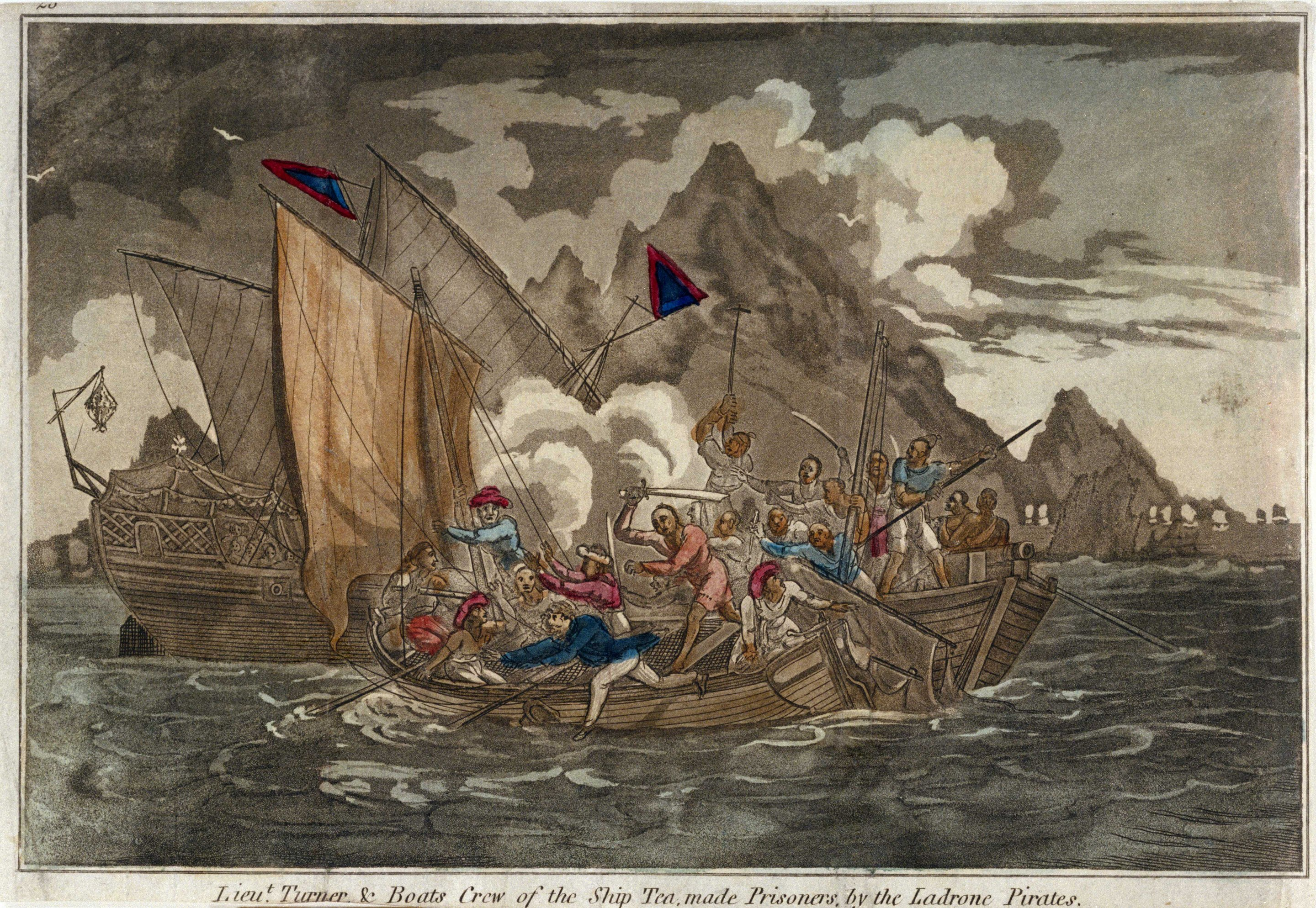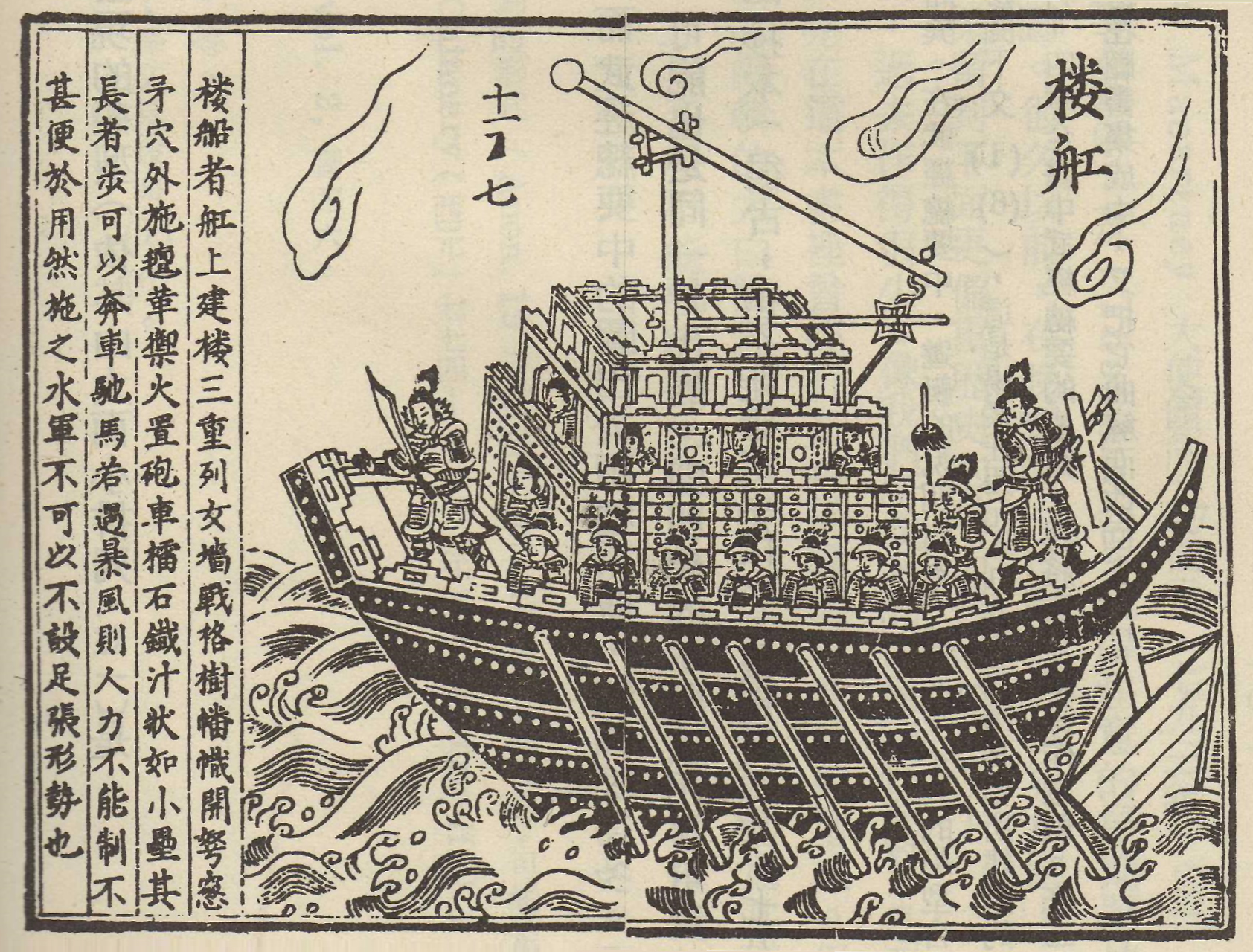

The World’s Most Successful Pirate: Zheng Yi Sao and the South China Sea
Summary
Reflection Questions
Journal Prompt
Zheng Yi Sao’s remarkable and audacious career as a swashbuckling marauder is a tale of adventure, cunning, and unprecedented success in a world dominated by men. Born into obscurity in the late 18th century, Zheng Yi Sao would ascend to command the largest pirate fleet in history, shaping the destiny of the South China Sea for nearly two decades. Her exploits, governance, and indomitable spirit make her not only one of the most successful pirates in history but also a trailblazing figure who defied gender norms and established her legacy as a legendary maritime icon. Let’s examine the captivating life and legacy of the world’s most successful pirate, Zheng Yi Sao.
Historical Context for Zheng Yi Sao’s Life and Reign
The 18th century was a period of significant maritime activity and trade in the South China Sea. This region was not only strategically important but also incredibly diverse in terms of its cultural, economic, and political influences.
The South China Sea was a central crossroads for international trade routes connecting Europe, Southeast Asia, China, and other parts of Asia. These routes facilitated the exchange of valuable commodities such as spices, silk, tea, porcelain, and precious metals. European powers like Portugal, Spain, the Netherlands, and later, Britain, were keenly interested in accessing these trade routes.
European colonial powers were vying for control of territories in Southeast Asia and the surrounding regions. This competition for colonial dominance led to conflicts and tensions, further destabilizing the South China Sea.
The Emergence of Piracy in the South China Sea


China’s Ming Dynasty (1368-1644) and later the Qing Dynasty (1644-1912) held significant influence over the South China Sea region. China sought to assert its control over this vital waterway and establish itself as the dominant power in the region. The emergence of piracy in the South China Sea was a direct response to the thriving trade and the chaos caused by political instability.
Pirates often took advantage of the vastness and complexity of the sea, launching raids on merchant vessels and coastal settlements. The presence of powerful pirate factions made the South China Sea a perilous place for maritime commerce. Numerous islands, coves, and narrow straits along the South China Coast provided ideal hiding places for pirate fleets, making it difficult for authorities to suppress piracy effectively.
As trade routes flourished, piracy became an attractive and lucrative endeavor for those seeking wealth and power. Notable Chinese pirates such as Cheng I and Cheng I Sao, often referred to as the “Pirate Confederation,” played a significant role in this era. The Pirate Confederation, led by the formidable Cheng I Sao, commanded a vast fleet of pirate ships that terrorized the South China Sea.
Amid this landscape, Zheng Yi Sao’s rise to prominence as a pirate queen and her ability to navigate the complex web of political and economic factors of the 18th-century South China Sea is all the more remarkable. Her story serves as a captivating window into the challenges and opportunities that defined this vibrant and dynamic maritime region during that period.
Origins of the Greatest Pirate Queen China Ever Saw
Also called Ching Shih, Zheng Yi Sau was born Shi Yang in the Guangdong province of China in 1775. She was the daughter of a fisherman. Her early years were unremarkable, although historians note that the Cantonese prostitute worked on a floating brothel as a young woman.
However, her life took a dramatic turn when she married Zheng Yi, a notorious pirate who would become her partner in crime and love. Zheng Yi Sao’s journey into piracy began when she joined her husband in his pirate activities, ultimately demonstrating her remarkable leadership and strategic capabilities. These qualities would propel her to become the infamous pirate queen of the South China Seas and leader of a massive pirate confederation.
Zheng Yi Sao’s Rise to Power


As noted above, Zheng Yi Sao’s journey into the world of piracy began with her marriage to Zheng Yi, a notorious pirate who operated in the South China Sea during the early 19th century. Their union marked the beginning of a formidable partnership that would eventually reshape the pirate landscape of the region.
Zheng Yi, already an established pirate, recognized in his wife a remarkable blend of intelligence and determination. Together, they embarked on a daring life of piracy, combining their strengths to establish a potent force that would later become the Red Flag Fleet. The Chinese woman proved herself not just as a pirate consort but as an equal partner in their criminal enterprise, setting the stage for her eventual ascendancy to leadership as the most fearsome Chinese pirate in history.
Formation of the Red Flag Fleet
The Red Flag Fleet emerged as a dominant pirate organization under the joint leadership of Zheng Yi and Ching Shih. Their fleet grew rapidly, with pirate ships numbering in the hundreds, each flying the infamous red flags that struck fear into the hearts of those who encountered them. Ching Shih’s strategic acumen was instrumental in the fleet’s expansion and success.
The female pirate recognized the need for organization and discipline among her pirates and implemented a strict code of conduct that governed every aspect of their activities. This code not only maintained order but also fostered a sense of unity and loyalty among her crews.
As the Red Flag Fleet continued to grow in size and influence, it became one of the most powerful and feared pirate factions in history, dominating the South China Sea and challenging the might of governments and naval forces in the region. Ching Shih’s leadership played a pivotal role in shaping the fleet’s identity and reputation.
Growth of Their Pirate Empire Under Ching Shih’s Command
After the death of Zheng Yi in 1807, Ching Shih took command of the pirate confederation he had founded, which would become the Red Flag Fleet. Her leadership marked a significant turning point in her life, as she rose to become one of the most influential pirates in history. She managed the affairs of the Red Flag Fleet with a combination of strategic acumen and an innovative governance structure.
Under the leadership of Zheng Yi Sao, the Red Flag Fleet rapidly expanded its influence in the South China Sea during the early 19th century. The fleet, consisting of hundreds of pirate ships, effectively controlled key maritime routes and coastal areas, striking fear into the hearts of both merchants and local authorities. Their dominance extended from the waters off the southern coast of China to as far south as Vietnam.
The sheer size and power of the Red Flag Fleet allowed them to impose tribute demands on coastal communities, effectively extracting wealth from the regions they controlled. This expansion marked a period of unprecedented pirate dominance in the South China Sea, as Zheng Yi Sao’s formidable leadership and strategic prowess enabled her to achieve unmatched success in the realm of piracy.
Examining Zheng Yi Sao’s Unique Governance Structure
What set the Red Flag Fleet apart from other pirate groups of the time was Zheng Yi Sao’s innovative approach to governance. She implemented a highly structured and disciplined system of leadership, wherein each ship in her fleet had a designated commander, often elected by the crew, who reported directly to her. This decentralized command structure allowed for efficient decision-making and adaptability in the face of threats or opportunities.
Ching Shih herself held the ultimate authority and made crucial decisions regarding strategy, alliances, and distribution of spoils. Her ability to maintain control over a vast and diverse pirate organization showcased her leadership skills and contributed significantly to the fleet’s continued success in the face of persecution from the Chinese government.
Her Pirate Code
One of the most distinctive aspects of the Red Flag Fleet under Zheng Yi Sao’s leadership was the implementation of a comprehensive code of conduct. Her code of conduct was unheard of in Chinese piracy.
This code, known as the “Pirate Code” or “Articles of Agreement,” was a set of rules that governed every aspect of pirate life within the fleet. It included strict prohibitions against stealing from the local population, harming women, and engaging in unauthorized plundering. Violations of the code were met with severe punishment, including flogging, amputation, or execution.
The code also outlined a fair system for distributing captured wealth among the crew, with Ching Shih ensuring that her pirates received their fair share. This code of conduct not only maintained order and discipline within the fleet but also contributed to a sense of unity and loyalty among the pirates, further solidifying the Red Flag Fleet’s dominance in the South China Sea.
Notable Battles and Expeditions


During her time as the leader of the Red Flag Fleet, Ching Shih and her pirate forces engaged in various major battles and expeditions in the South China Sea. One of the notable battles she was involved in was the Battle of Tung Chung Bay.
Battle of Tung Chung Bay
In 1809, Ching Shih’s Red Flag Fleet clashed with Portuguese and Qing Dynasty naval forces in the Battle of Tung Chung Bay. This confrontation marked a significant turning point in her career as a pirate queen. Despite facing formidable adversaries, Ching Shih and her fleet successfully repelled the attackers and emerged victorious. The battle showcased her tactical prowess and the disciplined nature of her pirate organization. The victory at Tung Chung Bay solidified the Red Flag Fleet’s reputation as a force to be reckoned with in the South China Sea.
While the Battle of Tung Chung Bay is one of the most well-documented events in Ching Shih’s career, her entire reign as a pirate queen was marked by a series of daring expeditions, strategic maneuvers, and relentless efforts to assert her dominance in the South China Sea. These activities cemented her legacy as one of the most successful and feared pirates in history.
Other Expeditions and Important Events
Ching Shih’s Red Flag Fleet was notorious for its raids on coastal towns and fishing villages along the South China Sea. These raids were carried out to plunder wealth, goods, and resources from local communities. Coastal settlements throughout the region fell victim to the ruthless activities of her pirates.
Ching Shih’s fleet also controlled vital trade routes in the South China Sea. They often intercepted merchant vessels and demanded tribute payments from coastal areas in exchange for safe passage. The dominance of the Red Flag Fleet disrupted regional trade and instilled fear among traders and merchants.
Ching Shih’s influence extended beyond raiding and looting. Madame Ching formed alliances with other pirate leaders in the region, such as Cheung Po Tsai, who later became her husband. These alliances allowed her to expand her pirate empire further and exert control over an extensive maritime territory.
Zheng Yi Sao’s Impact and Legacy
After her rise to prominence in the pirate world, Ching Shih married Cheung Po Tsai, a former member of her pirate organization. Cheung Po Tsai had initially been a fisherman captured by the Red Flag Fleet but later joined their ranks and proved himself as a capable and loyal pirate. Their marriage not only strengthened Ching Shih’s position but also solidified Cheung Po Tsai’s role within the Red Flag Fleet. Cheung Po Tsai is an important figure in Chinese lore in his own right; Cheung Po Tsai Cave in Southern China was named after him.
Zheng Yi Sao’s impact on piracy in the South China Sea was profound and far-reaching. Under her leadership, the Red Flag Fleet became a dominant force, terrorizing maritime trade routes and coastal communities. Her success in establishing a disciplined and organized pirate organization set a new standard for pirate operations in the region.
The infamous Pirate Code she implemented not only maintained order within her fleet but also influenced other pirate groups to adopt similar codes of conduct. Zheng Yi Sao’s formidable reputation as a pirate queen inspired fear and respect, not only among her contemporaries but also among those who would come after her. Her legacy as a pioneer of organized piracy in the South China Sea would leave an indelible mark on the history of piracy, both regionally and globally.
Zheng Yi Sao’s Negotiation with the Qing Dynasty


Ching Shih’s marriage to Cheung Po Tsai coincided with her decision to negotiate a truce with the Qing Dynasty government. In 1810, recognizing the pressure from the Qing Dynasty navy and seeking a peaceful resolution, Zheng Yi Sao made a strategic decision to negotiate with the Qing government. Her negotiations with the Chinese Navy resulted in a remarkable agreement: she secured amnesty for herself and her pirate followers in exchange for disbanding the Red Flag Fleet and retiring from piracy.
This negotiation with the Qing Navy demonstrated her diplomatic skills and pragmatic approach to her circumstances. It also marked a turning point in the history of piracy in the South China Sea, as it highlighted the ability of a pirate leader to transition from a life of crime to a more lawful existence, paving the way for a new chapter in her life and in the annals of piracy.
Zheng Yi Sao in Retirement
After retiring, the Chinese pirate lived the remainder of her life in a more subdued manner, running a gambling house and raising a family with her husband, Cheung Po Tsai. Her ability to retain much of her ill-gotten wealth and avoid prosecution by the Qing Dynasty was a testament to her shrewdness and adaptability. Zheng Yi Sao’s legacy is one of a remarkable figure who not only achieved unprecedented success as a pirate but also managed to navigate the complex waters of the South China Sea’s piracy-infested history.
Depictions of Zheng Yi Sao in Literature and Pop Culture
Depictions of Zheng Yi Sao, also known as Ching Shih, in literature and pop culture have been relatively limited compared to some other historical figures, but her story has nonetheless inspired various forms of artistic expression. Below are a few notable examples.
In The Pirate Women: The Princesses, Prostitutes, and Privateers Who Ruled the Seven Seas, Laura Sook Duncombe explores the lives of several women in history who became pirates, including a section on Ching Shih. It sheds light on her life and achievements, highlighting her significance in the world of piracy.
Pirates of the Caribbean: At World’s End featured fictionalized versions of historical pirates, and while it doesn’t specifically include Ching Shih, it contributes to the romanticized image of piracy in popular culture, which indirectly draws inspiration from real-life figures like her. In fact, her story served as background for the powerful Mistress Ching, who was one of the nine pirate lords in the film.
Some video games set in historical or pirate-themed settings have also featured characters or factions inspired by Ching Shih. These games often include pirate queens or female pirate leaders who share similarities with her story and persona.
The Importance of Covering Zheng Yi Sao’s Unique Story
In the 18th century, piracy was primarily a male-dominated world. Women were often relegated to the roles of consorts or bystanders in the pirate lifestyle. However, Zheng Yi Sao’s story stands as a remarkable exception to this prevailing narrative. She not only entered the world of piracy but rose to become one of its most influential leaders.
Her story challenges the traditional portrayal of women in piracy during that era and underscores the fact that gender did not limit her ambitions or capabilities. Zheng Yi Sao’s success demonstrated that women could not only participate in but also excel in roles that were historically reserved for men, breaking the conventional norms of her time.
Her Remarkable Achievements in a Male-Dominated World
Zheng Yi Sao’s achievements in the male-dominated world of piracy are nothing short of extraordinary. As the leader of the Red Flag Fleet, she managed to command the loyalty and respect of thousands of pirates and successfully navigated the complex waters of the South China Sea. Her strategic brilliance, effective governance, and the establishment of a comprehensive code of conduct within her pirate organization set her apart as a leader of exceptional skill and vision.
In an industry where brutality and lawlessness were the norm, Zheng Yi Sao’s disciplined approach to piracy and her ability to maintain order within her fleet were truly remarkable. Her story serves as a testament to her indomitable spirit and serves as an inspiration for women throughout history who have defied societal expectations and achieved greatness in fields traditionally dominated by men.
Final Thoughts on the Life and Legacy of the Famous Female Pirate
The enduring legacy of Zheng Yi Sao extends far beyond her pirate exploits. Her disciplined governance structure, the implementation of a code of conduct within her pirate organization, and her successful negotiation with the Qing Dynasty government offer valuable lessons in leadership, adaptability, and resilience. Zheng Yi Sao’s story reminds us that remarkable individuals can emerge from unexpected places, breaking down barriers and redefining the course of history.
Her impact on piracy in the South China Sea and her ability to navigate a male-dominated world serve as a testament to the enduring power of determination, leadership, and the indomitable human spirit. Her story continues to captivate and inspire, proving that even in the most challenging of circumstances, individuals have the capacity to achieve greatness and reshape the world in their own image.








